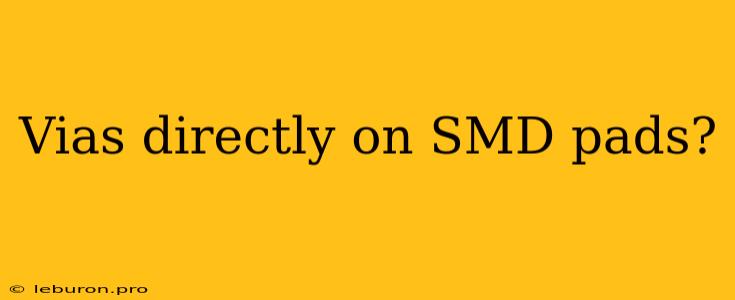Soldering Vias Directly on SMD Pads: A Comprehensive Guide
Soldering vias directly on SMD pads is a technique that can significantly reduce the size and complexity of printed circuit boards (PCBs). This approach eliminates the need for separate vias, reducing the overall board footprint and potentially improving signal integrity. While it offers potential benefits, it also presents unique challenges and requires careful consideration. This article delves into the intricacies of soldering vias directly on SMD pads, covering the advantages, disadvantages, design considerations, and best practices for successful implementation.
Understanding the Technique
Directly soldering vias onto SMD pads involves creating a conductive connection between layers of a PCB through a via that is placed on the surface of the pad, instead of drilling a hole through the board. This method is typically employed when space constraints necessitate a compact design. The process can be achieved through various techniques, including laser drilling and through-hole plating.
Advantages of Soldering Vias Directly on SMD Pads
Reduced Board Size
One of the most significant advantages of this technique is the reduction in board size. By eliminating the need for separate vias, the overall footprint can be minimized, leading to smaller and more compact designs. This is particularly beneficial in applications where space is at a premium, such as mobile devices, wearable electronics, and high-density packaging.
Enhanced Signal Integrity
Soldering vias directly on SMD pads can potentially improve signal integrity, particularly at high frequencies. This is because the vias are placed closer to the signal traces, reducing the inductance and capacitance associated with the signal path.
Cost-Effective Solution
In some cases, this technique can be more cost-effective than traditional methods. By eliminating the need for separate vias, the manufacturing process can be simplified, potentially reducing the overall cost of the board.
Disadvantages of Soldering Vias Directly on SMD Pads
Increased Manufacturing Complexity
Soldering vias directly on SMD pads can be more complex to manufacture than traditional methods. The process requires precise alignment and control, and it may be challenging to ensure consistent and reliable connections.
Potential for Solder Defects
The smaller size of the vias and the proximity to the SMD pads can increase the risk of solder defects. This can include issues like solder bridging, voids, and insufficient wetting.
Design Considerations
Choosing the Right Material
The choice of materials is crucial for successful implementation. The via material should be compatible with the SMD pad material and the soldering process. In many cases, copper is the preferred material for vias, but other materials may be suitable depending on the specific application.
Via Size and Placement
The size and placement of the vias are critical factors that need to be carefully considered. The via size should be sufficient to handle the current flow and the heat dissipation, while the placement needs to ensure proper alignment with the SMD pad.
SMD Pad Design
The design of the SMD pad is equally important. The pad should be large enough to accommodate the via and provide sufficient surface area for soldering. The pad shape and design can also impact the solder joint quality.
Soldering Process
The soldering process is another critical aspect that needs to be optimized for direct via soldering. The temperature profile, soldering time, and solder paste selection all play a role in ensuring the quality of the connections.
Best Practices for Direct Via Soldering
Optimize the Design
Start by optimizing the PCB design to ensure that the vias are placed strategically and the SMD pads are appropriately designed.
Utilize High-Quality Materials
Choose high-quality materials for the vias and the SMD pads to minimize the risk of defects.
Employ Advanced Manufacturing Processes
Utilize advanced manufacturing processes like laser drilling and through-hole plating for reliable and repeatable results.
Implement Quality Control Measures
Implement rigorous quality control measures throughout the manufacturing process to ensure the integrity of the soldered vias.
Conclusion
Soldering vias directly on SMD pads presents a potential solution for reducing board size and enhancing signal integrity, but it's not without its challenges. Carefully considering the design considerations, material choices, and manufacturing processes is crucial to ensure successful implementation. By following best practices and utilizing advanced technologies, engineers can leverage this technique to create highly compact and efficient PCBs. As technology advances, we can expect to see further improvements in the methods and techniques used for direct via soldering, leading to even more innovative and complex designs.
